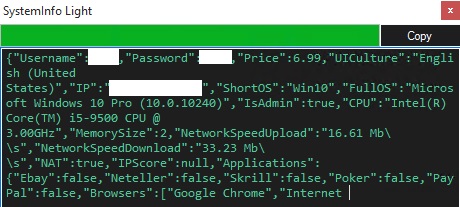PUA.MSIL.SysChecker.A
TR/Hacktool.rguwt (ANTIVIR)
Windows


Threat Type: Potentially Unwanted Application
Destructiveness: No
Encrypted: No
In the wild: Yes
OVERVIEW
This Potentially Unwanted Application arrives on a system as a file dropped by other malware or as a file downloaded unknowingly by users when visiting malicious sites.
It does not have any propagation routine.
It does not have any backdoor routine.
It does not have any information-stealing capability.
TECHNICAL DETAILS
Arrival Details
This Potentially Unwanted Application arrives on a system as a file dropped by other malware or as a file downloaded unknowingly by users when visiting malicious sites.
Other System Modifications
This Potentially Unwanted Application adds the following registry entries:
HKEY_LOCAL_MACHINE\SYSTEM\ControlSet001\
services\ASP.NET_{Version Number}\Names
{Random Alphanumeric Characters} = 1864
Propagation
This Potentially Unwanted Application does not have any propagation routine.
Backdoor Routine
This Potentially Unwanted Application does not have any backdoor routine.
Rootkit Capabilities
This Potentially Unwanted Application does not have rootkit capabilities.
Information Theft
This Potentially Unwanted Application does not have any information-stealing capability.
Other Details
This Potentially Unwanted Application does the following:
- It gathers the following system information:
- OS Information
- CPU Information
- Memory Size
- Admin Rights
- System Language
- Username
- Logon Password
- Hostname
- Network Speed
- Public IP Address
- ISP Information
- Installed Browsers
- Specific Visited SItes
- It checks if the following browsers are installed in the system:
- Google Chrome
- Internet Explorer
- Mozilla Firefox
- Opera
- It checks if the following sites have been visited by the user:
- Ebay
- Full Tilt
- Neteller
- Party Poker
- Paypal
- Poker Stars
- Skrill
- It connects to the following URL to test the network speed:
- https://www.{BLOCKED}oject.com
- It connects to the following URLs to get the public IP address and ISP information of the system:
- http://{BLOCKED}zip.com/
- http://{BLOCKED}o.io/json
- http://www.{BLOCKED}e.com/geoip
- It creates the following window to display the gathered information from the system:

NOTES:
It does not exploit any vulnerability.
SOLUTION
Step 1
Before doing any scans, Windows 7, Windows 8, Windows 8.1, and Windows 10 users must disable System Restore to allow full scanning of their computers.
Step 2
Note that not all files, folders, and registry keys and entries are installed on your computer during this malware's/spyware's/grayware's execution. This may be due to incomplete installation or other operating system conditions. If you do not find the same files/folders/registry information, please proceed to the next step.
Step 3
Delete this registry value
Important: Editing the Windows Registry incorrectly can lead to irreversible system malfunction. Please do this step only if you know how or you can ask assistance from your system administrator. Else, check this Microsoft article first before modifying your computer's registry.
- In HKEY_LOCAL_MACHINE\SYSTEM\ControlSet001\services\ASP.NET_{Version Number}\Names
- {Random Alphanumeric Characters} = 1864
- {Random Alphanumeric Characters} = 1864
Step 4
Scan your computer with your Trend Micro product to delete files detected as PUA.MSIL.SysChecker.A. If the detected files have already been cleaned, deleted, or quarantined by your Trend Micro product, no further step is required. You may opt to simply delete the quarantined files. Please check the following Trend Micro Support pages for more information:
Did this description help? Tell us how we did.


